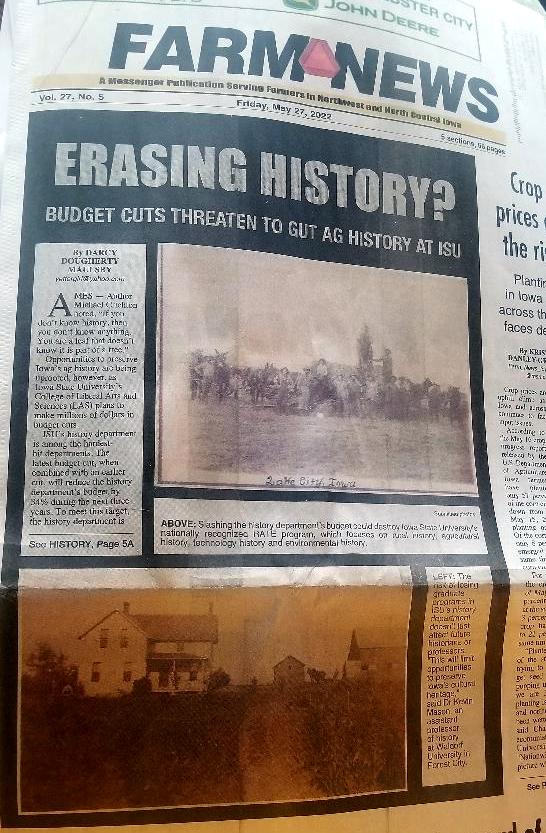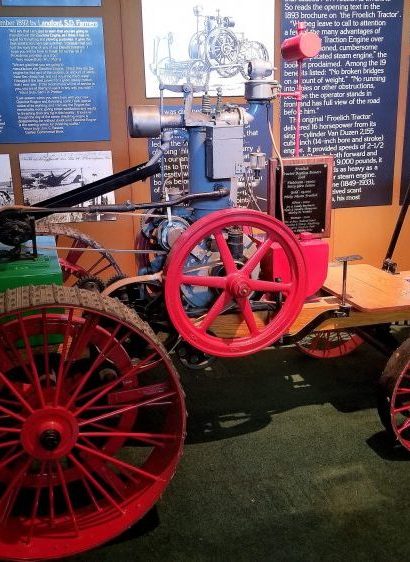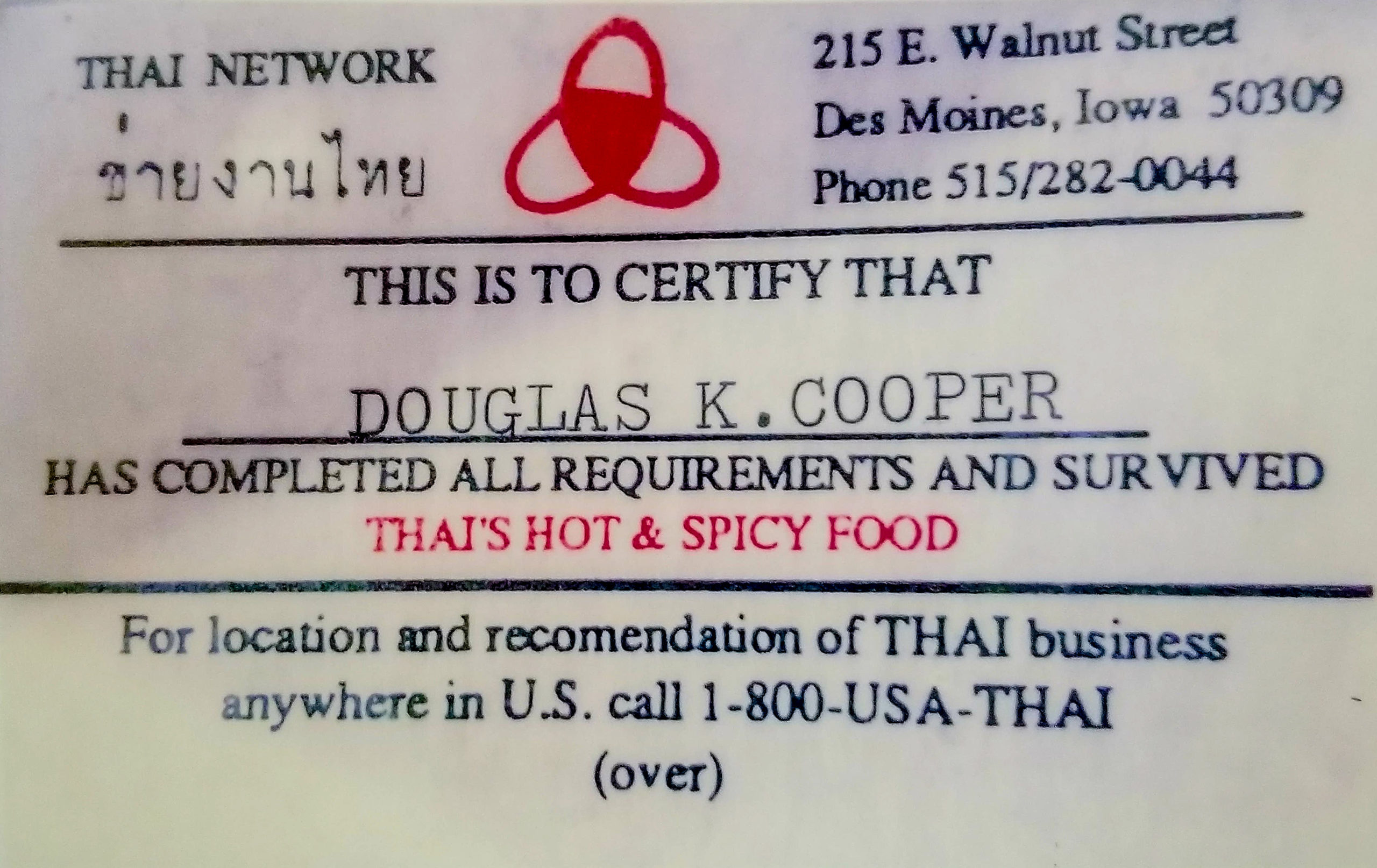
Whats HOT
Latest Posts
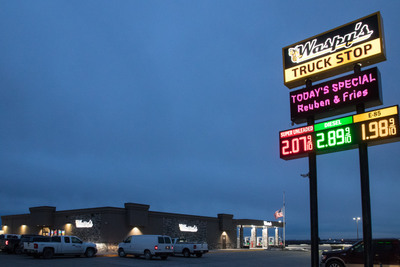
Hog Trailers to Humidors: Two New Iowa Convenience Stores Reflect “Waspy’s Way”
Step into the new Waspy’s truck stop in Audubon along Highway 71, and it feels more like an upscale corner grocery than a convenience store, from the coolers of fresh produce and healthy snacks at one end to the walk-in “spirits den” filled with wine, liquor and a humidor for fine cigars at the other end.
But explore a little more, and it’s clear this is a working truck stop, from the laundry and shower area to the truckers’ lounge in the hall that connects the store with the Feed Mill Restaurant. After all, the whole Waspy’s concept started from a basic need rooted in the farm.
“When you’re hauling livestock in western Iowa, it’s hard to find a truck wash,” said Brian Handlos, whose family owns and operates Waspy’s, which has locations in Audubon and Templeton. “We decided this would be a service we could provide.”
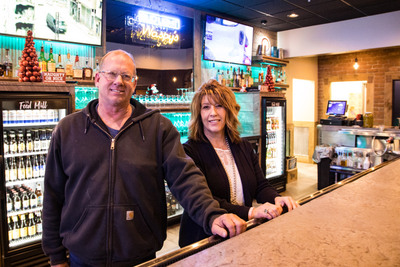 It turned out that one good idea planted the seed for a whole new crop of businesses, including a $7 million, full-service truck stop in Templeton on 6.3 acres near the junction of Highway 141 and Highway 71. The convenience store, car wash and fuel stations opened in May 2017. The opportunity was too good to pass up, since 5,000 vehicles pass by on Highway 141 daily, according to Waspy’s website.
It turned out that one good idea planted the seed for a whole new crop of businesses, including a $7 million, full-service truck stop in Templeton on 6.3 acres near the junction of Highway 141 and Highway 71. The convenience store, car wash and fuel stations opened in May 2017. The opportunity was too good to pass up, since 5,000 vehicles pass by on Highway 141 daily, according to Waspy’s website.
The 16-acre Audubon complex represents an $18 million investment in the local economy, thanks to the 24/7 convenience store/truck stop that opened August 24, 2018; the restaurant/bar that opened September 4, 2018; and the 36-room Blue Grass Inn & Suites hotel with an indoor pool that opened August 1, 2018. A 40,000-square-foot truck service station is slated to open at the Audubon Waspy’s this spring to provide tire repair, truck wash-out services and more.
“We tried to think of everything,” said Beth Handlos, who runs the business with her brother and their parents, Lawrence “Waspy” Handlos and his wife, Doris. “These businesses all feed off each other, and the potential here is incredible.”
Growing opportunities in rural Iowa
To say that Waspy’s is not the typical truck stop is an understatement. Yet it’s as homegrown as the business’s namesake. Now in his early 80s, Lawrence Handlos grew up on a farm near Willey, Iowa. He got the nickname “Waspy” from his father, John, a German immigrant who settled in the Carroll area.
“He gave Lawrence that nickname as a child, because it’s tied to another German name that his father liked, Sebastian,” Beth Handlos said. “’Waspy’ stuck with Lawrence ever since, and now it’s a memorable brand name for our family’s truck stops.”
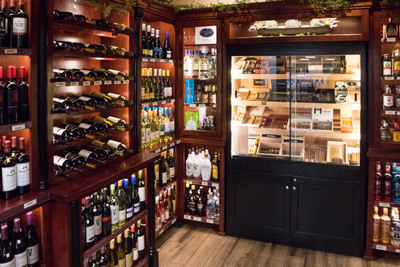 The name isn’t the only memorable thing about Waspy’s, which is redefining the truck stop/convenience store experience with these 10 business practices:
The name isn’t the only memorable thing about Waspy’s, which is redefining the truck stop/convenience store experience with these 10 business practices:
1. Put the customer first. Being locally owned and family owned means paying extra attention the little things, from greeting customers by name at the convenience store to making sure the hotel rooms are extra clean—just the way Doris Handlos would want it. “We say it’s not just clean—it’s ‘Doris clean,’” Beth Handlos said.
2. Follow servant leadership. The Handlos family emphasizes that their employees don’t work for them; they work with them. “It’s a team effort,” Beth Handlos said. “It’s certainly not below us to bus the tables at the restaurant.”
3. Give back to the community. Along with creating nearly 100 new jobs in the Audubon/Templeton area, Waspy’s creates community hubs where people of all ages can gather together. “We’re humbled to be part of people’s lives every day,” said Beth Handlos, who noted there are no outside investors in Waspy’s.
4. Focus on local. Like many rural Iowa towns, Audubon once had a thriving business district filled with motels, a jewelry store and more. “For years, however, I watched Audubon slowly dwindle,” said Beth Handlos, who grew up on a farm and graduated from Audubon High School in 1982. When the Handlos family built their Waspy’s truck stops, 75 percent of the contractors were located within 30 miles of the local community. “It’s exciting to see how dollars spent at Waspy’s are being reinvested in our local communities to spur more economic development,” Beth Handlos added.
5. Learn from success. While making mistakes goes along with any new business, the Handlos family has worked hard to shorten their learning curve. “We look to lots of different businesses to see what’s working and what’s not,” said Beth Handlos, a former program coordinator with Iowa State University Athletics’ marketing department. “We borrow good ideas anywhere we can find them.”
6. Don’t take shortcuts. Running a successful business requires the discipline to put in the hours and do things the right way—the only way, said Brian Handlos. “Nothing was ever handed to my parents. They worked hard all their lives and passed this work ethic onto us. We all wear a lot of hats around here, but if we do the right things, everything will fall into place.”
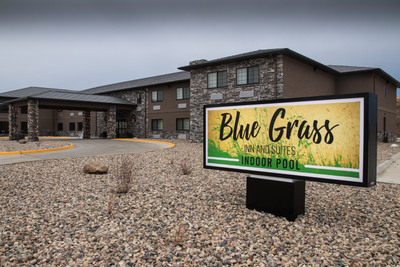 7. Add the personal touch. Extended hours and friendly service attract local customers and those just passing through. “We love what we do,” Beth Handlos said. “It’s all about the friendships you make.”
7. Add the personal touch. Extended hours and friendly service attract local customers and those just passing through. “We love what we do,” Beth Handlos said. “It’s all about the friendships you make.”
8. Rethink what’s possible. Brian Handlos and his wife, Pat, have run Two Palms Grilling for many years and have gained a loyal following. Two Palms plans to supply vacuumed-packed smoked meats at Waspy’s convenience stores. “I like showing people what great pork should taste like,” said Brian Handlos, who finishes nearly 250,000 pigs a year with his family and employees.
9. Expand opportunities. The Handlos family is always looking for ways to make their businesses more inviting. The indoor pool in the 36-room hotel in Audubon isn’t only available to guests. There are open hours where the public can pay a fee to swim, plus there’s a rentable party room near the pool. Even the parking lots at the Audubon complex create a more user-friendly experience. “When drivers are hauling 210-foot-long wind turbine blades, they often can’t find a place to park,” said Brian Handlos, who added that Waspy’s has parking spaces for 70 semi-trucks. “They can line up 10 to 15 trucks here at Waspy’s.”
10. Stay true to your roots. Everything at Waspy’s speaks to the business’s rural roots, from the rustic décor at the Feed Mill Restaurant to the homegrown ethanol blends (including E85) in the fuel pumps. “A lot of blood, sweat, tears and money have gone into these businesses, but it’s worth it,” Beth Handlos said. “We’re proud to support our hometown.”

This article first appeared in Farm News in February 2019.
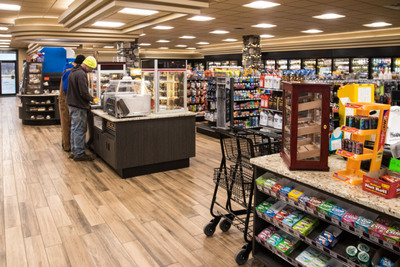
Want more?
Thanks for stopping by. I invite you to read more of my blog posts if you value intriguing Iowa stories and history, along with Iowa food, agriculture updates, recipes and tips to make you a better communicator.
If you like what you see and want to be notified when I post new stories, be sure to click on the “subscribe to blog updates/newsletter” button at the top of this page, or click here. Feel free to share this with friends and colleagues who might be interested, too.
Also, if you or someone you know could use my writing services (I’m not only Iowa’s storyteller, but a professionally-trained journalist with 20 years of experience), let’s talk. I work with businesses and organizations within Iowa and across the country to unleash the power of great storytelling to define their brand and connect with their audience through clear, compelling blog posts, articles, news releases, feature stories, newsletter articles, social media, video scripts, and photography. Learn more at www.darcymaulsby.com, or e-mail me at yettergirl@yahoo.com.
If you’re hungry for more stories of Iowa history, check out my top-selling “Culinary History of Iowa: Sweet Corn, Pork Tenderloins, Maid-Rites and More” book from The History Press. Also take a look at my latest book, “Dallas County,” and my Calhoun County” book from Arcadia Publishing. Both are filled with vintage photos and compelling stories that showcase he history of small-town and rural Iowa. Order your signed copies today! Iowa postcards are available in my online store, too.
Let’s stay in touch. I’m at darcy@darcymaulsby.com, and yettergirl@yahoo.com.
Talk to you soon!
Darcy
@Copyright 2019 Darcy Maulsby & Co. Blog posts may only be reprinted with permission from Darcy Maulsby.

Smart Marketing Lessons from an Uber Driver–Listen Up!
Ever used Uber? If you have, I bet your ride was in a city. One of my entrepreneurial friends, Pat, recently started driving for Uber and Lyft here in rural Iowa. Through smart marketing, he’s carving quite a niche.
“I really didn’t realize how much influence the driver has,” Pat told me recently. The other evening, for example, he picked up two guys in a northern Iowa community who said they wanted a ride to the local casual dining/sports bar hangout several blocks away. Then Pat asked, “What do you want to do, eat wings or party?”
“Party!”
“Then we’ll go to a party bar,” Pat said. They agreed, and he drove them 2 miles down the road. He also picked them up again when they were ready to leave.
I love this story, because it highlights some basic keys to successful marketing:
• Take the time to ask the right questions.
• Listen carefully to the answers.
• Help clients reach their goals.
“See, you’re adding value!” I told Pat. “That’s what a great marketer does. You asked the right questions to get to the core of what these guys really wanted, plus you put more money in your pocket. Bravo!”
Marketing takeaway: Asking questions and listening are essential to successful marketing. What key questions do you ask your clients/prospects? Are there more questions you can ask to better serve their needs and become the business partner of choice?
Want more?
Thanks for stopping by. I invite you to read more of my blog posts if you value intriguing Iowa stories and history, along with Iowa food, agriculture updates, recipes and tips to make you a better communicator.
If you like what you see and want to be notified when I post new stories, be sure to click on the “subscribe to blog updates/newsletter” button at the top of this page, or click here. Feel free to share this with friends and colleagues who might be interested, too.
Also, if you or someone you know could use my writing services (I’m not only Iowa’s storyteller, but a professionally-trained journalist with 20 years of experience), let’s talk. I work with businesses and organizations within Iowa and across the country to unleash the power of great storytelling to define their brand and connect with their audience through clear, compelling blog posts, articles, news releases, feature stories, newsletter articles, social media, video scripts, and photography. Learn more at www.darcymaulsby.com, or e-mail me at yettergirl@yahoo.com.
If you’re hungry for more stories of Iowa history, check out my top-selling “Culinary History of Iowa: Sweet Corn, Pork Tenderloins, Maid-Rites and More” book from The History Press. Also take a look at my latest book, “Dallas County,” and my Calhoun County” book from Arcadia Publishing. Both are filled with vintage photos and compelling stories that showcase he history of small-town and rural Iowa. Order your signed copies today! Iowa postcards are available in my online store, too.
Let’s stay in touch. I’m at darcy@darcymaulsby.com, and yettergirl@yahoo.com.
Talk to you soon!
Darcy
@Copyright 2019 Darcy Maulsby & Co. Blog posts may only be reprinted with permission from Darcy Maulsby.
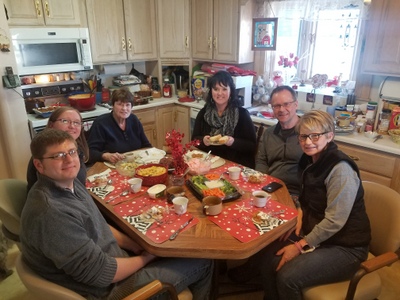
From My Kitchen to Yours: Comfort Food, Conversation and Living History Farms
Ever get an email that jumps out at you? It happened me to last July when one arrived with the subject line “Greetings from Living History Farms.” It was from my friend, Jim Dietz-Kilen, a former classmate from the Ag-Urban Leadership Initiative, and his note intrigued me.
“I have an idea for your consideration,” wrote Jim, who is the vice president of development for Living History Farms (LHF). “We are planning our annual gala, Farmstasia. We try to put together unique experience packages for our auction, with emphasis on agriculture/rural life and Iowa history. My idea is to build a package around you. While I am very open to other ideas, I wanted to run the following request by you:
• Would you be willing to donate a signed book? Any of your books would be wonderful, but I am partial to the Culinary History of Iowa.
• Would you also be willing to host a family at your farm to show them a bit of what your lives are like?
• Finally, would you be willing to serve these guests a meal selected from your book?
I know this is asking a lot, Darcy, but I have learned that you never know until you ask. And, as Wayne Gretzky said, ‘Every shot you don’t take is a miss.'”
By this point, I was already brainstorming menu ideas.
I’m a big fan of LHF, which welcomes between 100,000 and 110,000 each year. This interactive, 500-acre outdoor museum that tells the amazing 300+ year story of how Iowans transformed the fertile prairies of the Midwest into the most productive farmland in the world. As I wrote in this blog for Latham Hi-Tech Seeds, I love how LHF encourages people of all ages to explore Iowa’s rural heritage, including the 1700 Ioway village, the 1850 pioneer farm, the 1875 town of Walnut Hill and the 1900 horse-powered farm.
“All proceeds from Farmstasia go to keep fees low for our education programs, helping make it possible for kids from across the state to come here for school visits and participate in other educational experiences,” Jim continued.
Jim knows what is near and dear to my heart. Iowa agriculture. Books. Classic Iowa farm cooking. LHF. Giving back to the community. Without hesitating, I said yes.

Living History Farms Iowa
Cookstoves, corncobs and storytelling
LHF came into my life in a big way in the summer of 1995, when my college internship led me to the 1900 farm, Flynn mansion and veterinary clinic, where I served as a historical interpreter and looked the part in my Victorian-inspired dresses and bonnets.
That summer changed my life in so many ways. I met my husband through this experience. I also expanded my cooking skills. By the end of the summer, I knew how to light a cookstove with crumpled newspapers and corncobs. I could make homemade noodles with no problem. I could bake cookies in an oven with no temperature gauge, other than the feel of the heat on your hand. I could milk a Jersey cow by hand and churn the cream into butter. I could plan a meal and feed a threshing crew. I could even run a treadle sewing machine and sew my own apron.
Looking back, I was a prepper in training who can live off the grid if I have to.
While I don’t use all those skills today, some have served me well for years, especially the cooking skills, the historical knowledge I gained and the storytelling skills I learned. As a historical interpreter, I was not only working in the kitchen of the 1900 farm fixing a meal, but I interacted with guests. As I shared stories about Iowa farm life in the early 1900s, I learned the importance of listening. I’m still embarrassed when I misunderstood one guest who asked, “Is that a coal stove?” but I heard him say, “Is that a cold stove?” so I replied, “No, it’s a warm one!”
Planning a memorable menu
I was thinking of those experiences last Saturday, February 16, when I delivered on my promise to provide the Farmtasia winning bidders with an authentic Iowa farm meal inspired by my book. I had actually started cooking the night before and then got up early on Saturday morning so I’d get everything done on schedule and have time to visit with my guests.
They pulled in the driveway at my family’s Century Farm near Lake City right on time. It was an honor to host Dave Bubeck, a corn breeder at Corteva Agriscience™ in Johnston; his wife, Denise; and their friends Ben and Michelle Parlett, who also live in the Des Moines area. As we gathered around the table at noon, I served:
• Garden Vegetable Soup
• Homemade Beer Bread
• Iowa Ham Balls
• Glazed Meat Loaf
• Garlic Cheesy Smashed Potatoes
• Relish tray and coleslaw salad
• Homemade apple crisp with Haralson apples grown on our farm
There was something magical happened as we sat in that 100+plus-year-old kitchen, talking farming, food, travel and LHF. Seems like we covered everything, from how to talk about GMOs to what it’s like subscribing to a meal delivery service. Two and a half hours later, when my guests departed, we all agreed it was a great experience—the kind of story-worthy experience that LHF inspires. Even better, we’re staying in touch through social media and my e-newsletter.
And to think it all started with a simple email and a spirit of service. It reminds me of this quote from Orison Swett Marden, who founded SUCCESS magazine in 1897.
“We must give more in order to get more. It is the generous giving of ourselves that produces the generous harvest.”
Let’s get cooking
If you’d like to create a taste of our classic Iowa farm dinner, here are some of my favorite recipes:
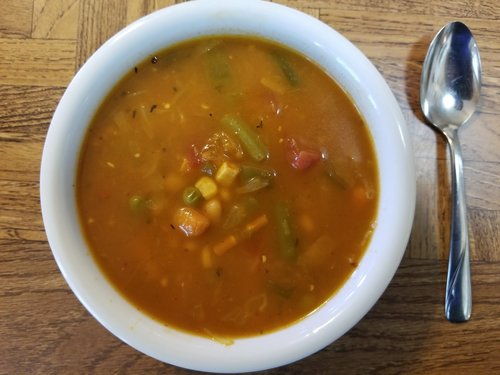
Hearty Homemade Vegetable Soup
Hearty Garden Vegetable Soup
I shared this tasty recipe in one my my monthly diary entries in 2018 for the Iowa Food and Family Project.
1 tablespoon olive oil
8 medium carrots, sliced
3 large onions, chopped
5 celery ribs, chopped
1 large green pepper, seeded and chopped
1 garlic clove, minced
2 cups chopped cabbage
2 cups frozen cut green beans (about 8 ounces)
2 cups frozen peas (about 8 ounces)
1 can (15 ounces) corn, or 2 cups fresh sweet corn
1 can (28 ounces) diced tomatoes, undrained
2 bay leaves
2 teaspoons chicken bouillon granules
1-1/2 teaspoons dried parsley flakes
1 tablespoon seasoning salt
1 teaspoon dried marjoram
1 teaspoon dried thyme
1/2 teaspoon dried basil
1/2 teaspoon pepper
7 cups water
1 teaspoon Worcestershire sauce
4 cups V8 vegetable juice
In a stockpot, heat oil over medium-high heat; sauté carrots, onions, celery and green pepper until crisp-tender. Add garlic; cook and stir 1 minute. Stir in remaining ingredients; bring to a boil. Reduce heat; simmer, covered, until vegetables are tender, 1 to 1-1/2 hours. Remove bay leaves.

Best Beer Bread
Best Beer Bread
2 cups self-rising flour
2 1 / 2 tablespoons sugar
1 12-ounce can of beer
Mix all ingredients together. Pour batter into a greased loaf pan. Bake at 350 degrees for 45 to 50 minutes.

Iowa Ham Balls
Iowa Ham Balls
This tasty, classic recipe comes from my friend Val Plagge, who is a wonderful farm cook.
2.5 pounds ham
2 eggs
1 1/2 cups graham cracker crumbs
1 cup milk
1 can tomato soup
3/4 cup brown sugar
1/4 cup white vinegar
1 teaspoon ground mustard
With a food processor, grind ham into small, chopped pieces (or buy ham loaf mix from local grocery store or butcher. This mix usually contains ham and ground pork, and sometimes ground beef, too). Add eggs, graham cracker crumbs and milk. Mix together with your hands, and form fist-sized ham balls. (If the mixture seems a little dry, add 1/4 cup of milk at a time, up to 1 1/2 cups of milk total.) Place ham balls in a greased 9-inch by 13-inch pan. They fit nicely three across and five down.
Mix soup, brown sugar, vinegar and mustard until smooth. Drizzle glaze over the ham balls for the classic ham ball sauce. (Or, if you’re in a rush, drizzle your favorite barbecue sauce over the ham balls.) Bake at 350 Fahrenheit for 1 hour. Yield: 13-15 ham balls
Note: These ham balls freeze well and can be warmed up in a slow cooker, if desired. Ham balls are the perfect Iowa potluck treat!
Cheesy Garlic Mashers
Taking a twist on classic mashed potatoes, this recipe is loaded with flavor and offers the perfect comfort food.
Red Bliss or Yukon gold potatoes (use about one potato per person, although this will depend on the size of the potatoes)
6 garlic cloves (can use less, if you prefer)
Butter, 1 / 2 stick
Cream (use enough to give mashed potatoes the consistency you prefer)
1 carton sour cream (can substitute one carton of chip dip, if you prefer)
1 / 2 cup to 1 cup of Cheddar cheese
Seasoning salt and pepper, to taste
Chives, chopped
Bacon, 2 to 3 slices, fried
Boil potatoes in salted water with peeled, whole garlic cloves. When potatoes are done cooking, drain potatoes and garlic and place in a bowl with butter and cream. Mash together. Add more cream, if necessary, to achieve the consistency you prefer. Mix in sour cream and cheddar cheese. Season to taste with seasoning salt and pepper. Garnish with chopped chives and real bacon bits.
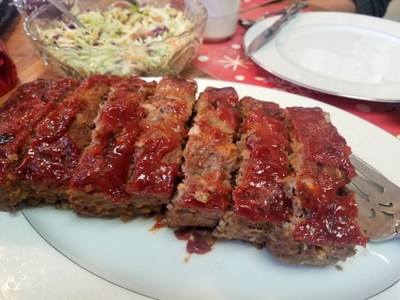
Glazed Meatloaf
Darcy’s Best Brown-Sugar Meatloaf
This recipe was inspired by the meatloaf that caterers prepared on the set in Iowa for the filming for “The Bridges of Madison County.” This is the only meatloaf recipe you’ll ever need!
1 pound ground beef
1 pound ground pork or ground turkey
1 cup herb-seasoned stuffing mix
1 onion, chopped
1 teaspoon salt
1/2 teaspoon freshly-ground pepper
1 teaspoon nutmeg
2 large eggs, lightly beaten
3 / 4 cup milk
2 tablespoons barbecue sauce
1 / 4 cup ketchup
2 tablespoons brown sugar
1 teaspoon dry mustard
Combine beef, pork or turkey, stuffing mix, onion, salt, pepper and nutmeg. In a separate bowl, beat eggs, milk, and barbecue sauce. Add to meat mixture, mixing well. Press into a meatloaf pan sprayed with non-stick cooking spray.
Combine ketchup, brown sugar, and mustard; spread over top of meat loaf. Bake, uncovered, at 350 degrees F for 1 hour and 30 minutes or until a thermometer inserted in the center of the loaf registers 160 degrees. Yield: 6 servings
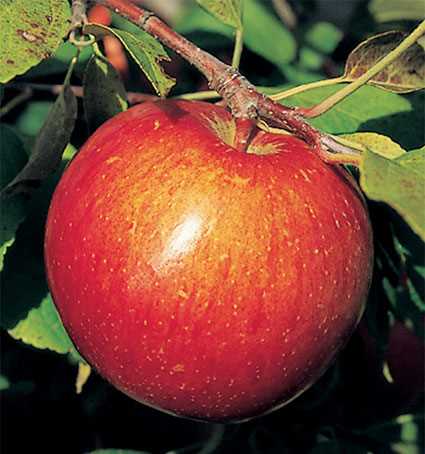
Haralson apple photo from Jung Seed
Farm-Fresh Apple Crisp with Whipped Cream
If you have the chance to visit a local apple orchard, pick up some Haralson apples, if they are available. We grow Haralsons on our farm, and their sweet-tart flavor works perfectly in apple pies and apple crisps.
Fruit Filling:
6 baking apples, peeled, cored and cut into wedges
1 tablespoon lemon juice
1 / 2 cup sugar
2 tablespoons flour (maybe need more, depending on how juicy the apples are)
Crumb topping:
1 1 / 4 cups flour
1 / 2 cup rolled oats
1 / 2 cup light brown sugar
1 / 2 teaspoon ground cinnamon
1 / 4 teaspoon salt
12 tablespoons butter (1 1/2 sticks), cut into small pieces
Preheat the oven to 350 degrees Fahrenheit.
For the fruit filling:
In a large mixing bowl, toss together the apples, lemon juice, sugar, and flour. Pour the apple mixture into a buttered 2-quart baking dish and set aside.
For the topping:
In a large mixing bowl, mix the flour, rolled oats, brown sugar, cinnamon, and salt. With a pastry blender, work the butter into the flour mixture just until mixture comes together and pea-sized clumps form.
Sprinkle the topping evenly over the fruit. Bake the apple crisp until the fruit is bubbling and the topping is golden brown and crisp, about 45 minutes.
Serve the crisp warm with vanilla bean ice cream or fresh whipped cream, if desired.
To make whipped cream, pour 1 cup of whipping cream into metal bowl on stand mixer. (Chill the bowl and whip attachment in the refrigerator first.) Begin mixing on high speed. As the cream starts to form into whipped cream, add powdered sugar a tablespoon at a time, until you achieve the sweetness you desire. Continue mixing on high until the mixture looks like thick whipped cream. Serve with apple crisp.
Want more?
Thanks for stopping by. I invite you to read more of my blog posts if you value intriguing Iowa stories and history, along with Iowa food, agriculture updates, recipes and tips to make you a better communicator.
If you like what you see and want to be notified when I post new stories, be sure to click on the “subscribe to blog updates/newsletter” button at the top of this page, or click here. Feel free to share this with friends and colleagues who might be interested, too.
Also, if you or someone you know could use my writing services (I’m not only Iowa’s storyteller, but a professionally-trained journalist with 20 years of experience), let’s talk. I work with businesses and organizations within Iowa and across the country to unleash the power of great storytelling to define their brand and connect with their audience through clear, compelling blog posts, articles, news releases, feature stories, newsletter articles, social media, video scripts, and photography. Learn more at www.darcymaulsby.com, or e-mail me at yettergirl@yahoo.com.
If you’re hungry for more stories of Iowa history, check out my top-selling “Culinary History of Iowa: Sweet Corn, Pork Tenderloins, Maid-Rites and More” book from The History Press. Also take a look at my latest book, “Dallas County,” and my Calhoun County” book from Arcadia Publishing. Both are filled with vintage photos and compelling stories that showcase he history of small-town and rural Iowa. Order your signed copies today! Iowa postcards are available in my online store, too.
Let’s stay in touch. I’m at darcy@darcymaulsby.com, and yettergirl@yahoo.com.
Talk to you soon!
Darcy
@Copyright 2019 Darcy Maulsby & Co. Blog posts may only be reprinted with permission from Darcy Maulsby.
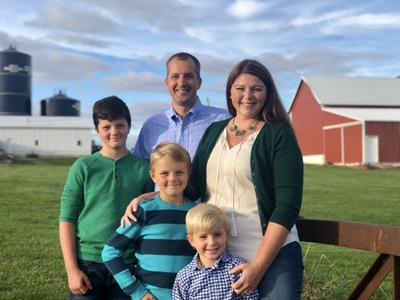
We Need FFA: Iowa Ag Secretary Mike Naig Reflects on His FFA Experiences
When you look at his formative years, my friend Mike Naig shouldn’t be where he is today, serving as Iowa’s Secretary of Agriculture. Even for him, it’s hard to shake memories of the Farm Crisis.
“As a child of the 1980s, I knew my parents didn’t want us to go through the same hardships they did,” said Naig, 40, the third of four Naig children who grew up on their family’s farm near Cylinder in northwest Iowa. “There was this mentality of ‘go do something other than farming,’ so my siblings and I were going to college and pursue careers off the farm.”
Naig considered studying veterinary medicine or a major related to human health. Yet there was something that planted a seed back then in Palo Alto County, something that would take root and shape Naig’s future in ways he could never imagine. That transformative experience was FFA.
“I never predicted I’d serve in a role like this, but I’m grateful for the life skills and ag knowledge I learned in FFA,” said Naig, who is one of Iowa’s most high-profile champions of FFA, especially during National FFA Week from February 16-23, 2019. “We need FFA.”
Naig speaks from experience. Before serving as Iowa’s Secretary of Agriculture, this Buena Vista University graduate worked in agribusiness for more than 13 years, serving in public policy roles for state and national trade associations and in private industry. He served as the Iowa Deputy Secretary of Agriculture under Bill Northey starting in September 2013.
When Northey joined the U.S. Department of Agriculture (USDA), Iowa Governor Kim Reynolds appointed Naig to succeed Northey as Iowa Secretary of Agriculture on March 5, 2018. Naig was elected Secretary of Agriculture in November 2018. Here’s his story:

Iowa Secretary of Agriculture Mike Naig
Q: How did your leadership journey begin?
A: Before I joined FFA, I was heavily involved in 4-H. The first meeting I ever chaired was at my local Independence Boosters 4-H Club. I stayed involved in 4-H through high school and served in all the officer roles. I also served on the 4-H Youth County Council in Palo Alto County. During high school, I went on a leadership trip to Washington, D.C. This helped spark my interest in government and politics.
Q: What role did FFA play in your years at Emmetsburg High School?
A: While I was involved with the student council and served as student body president in high school, I was really into soil judging with FFA. Before I graduated from high school in 1996, our soil judging team made it to state and then to the national competition in Oklahoma. All this fit well with my interest in science, soil quality and soil health. Those of us in FFA were fortunate to have a strong FFA chapter, a great advisor, Jerry Strand, and a supportive community. Although I didn’t know it back then, all this would provide a strong background for my career when I started working on soil and water quality policy issues.
Q: What lessons did you learn from your FFA experiences?
A: FFA teaches you that preparation pays off. The supervised agricultural experience (SAE) challenges you to come up with a project and see it through. This requires you to get organized, plan ahead and think strategically. For many kids, this is one of the first big tastes of responsibility they get. You also learn teamwork, since you have to work together to get things done. Competition is also important in FFA. You learn to put your best effort forward and win with grace. If you come up short, you learn from your mistakes and are encouraged to do better next time.
Q: How can FFA help Iowa meet the challenges of the twenty-first century?
A: FFA does a great job of helping kids learn about the rewarding, ag-related careers that are available in a variety of disciplines right here in Iowa. FFA also does an outstanding job of developing the next generation of ag leaders. This is important, because I see “volunteer fatigue” in many communities. There are plenty of opportunities to serve, including local churches, school boards, county Farm Bureau boards, co-op boards and hospital boards, but it can be hard to replace dedicated board members and volunteers who have served so well for many years. We have significant needs in our rural communities across the state, and we’ll need leaders like those in FFA today to step up and fill these important roles going forward.
Q: What excites you about the future of FFA and Iowa?
A: While these are challenging times in agriculture, there’s always reason for hope. Protein demand worldwide is growing, along with demand for bio-based fuels. Technology continues to advance and create new opportunities. There’s so much we have yet to discover in agriculture, which is exciting!
Iowa is at the epicenter of all this. We have something very special here, and it’s not just our rich soil. It’s our people. Rural Iowa can thrive when it’s guided by lifelong learners who are focused on continuous improvement to protect our precious natural resources and expand economic opportunities. FFA members will be part of this future, guided by the knowledge that feeding people is a noble profession. FFA has a strong record of developing leaders. It’s essential we keep FFA and ag education strong in our schools.
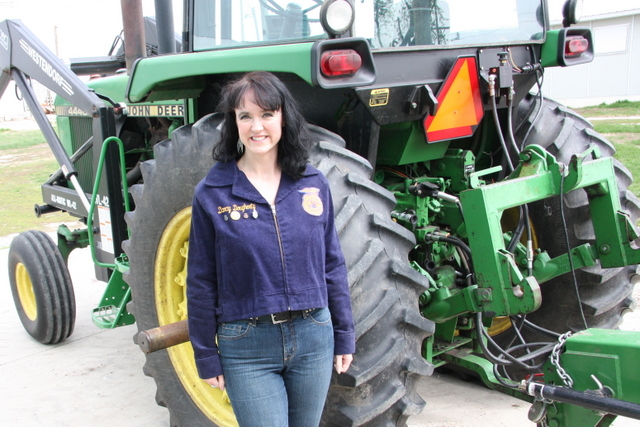
Forever proud to wear the iconic FFA blue jacket!
A note from Darcy:
I appreciate Mike’s comments about the importance of FFA and ag education for this story, which first appeared in Farm News. FFA played a critical role in helping me find my career, but boy, was it a strange, wacky, wonderful journey. Read the whole crazy story here.
Want more?
Thanks for stopping by. I invite you to read more of my blog posts if you value intriguing Iowa stories and history, along with Iowa food, agriculture updates, recipes and tips to make you a better communicator.
If you like what you see and want to be notified when I post new stories, be sure to click on the “subscribe to blog updates/newsletter” button at the top of this page, or click here. Feel free to share this with friends and colleagues who might be interested, too.
Also, if you or someone you know could use my writing services (I’m not only Iowa’s storyteller, but a professionally-trained journalist with 20 years of experience), let’s talk. I work with businesses and organizations within Iowa and across the country to unleash the power of great storytelling to define their brand and connect with their audience through clear, compelling blog posts, articles, news releases, feature stories, newsletter articles, social media, video scripts, and photography. Learn more at www.darcymaulsby.com, or e-mail me at yettergirl@yahoo.com.
If you’re hungry for more stories of Iowa history, check out my top-selling “Culinary History of Iowa: Sweet Corn, Pork Tenderloins, Maid-Rites and More” book from The History Press. Also take a look at my latest book, “Dallas County,” and my Calhoun County” book from Arcadia Publishing. Both are filled with vintage photos and compelling stories that showcase he history of small-town and rural Iowa. Order your signed copies today! Iowa postcards are available in my online store, too.
Let’s stay in touch. I’m at darcy@darcymaulsby.com, and yettergirl@yahoo.com.
Talk to you soon!
Darcy
@Copyright 2019 Darcy Maulsby & Co. Blog posts may only be reprinted with permission from Darcy Maulsby.

How Not to Invite Someone to Your Next Event–and 3 Solutions
Who’d like to attend another meeting? Not me. You’re probably not looking for another time suck, either. But when you’re the one hosting the meeting, how do you entice people to attend? After all, your meeting is going to be filled with valuable information that will make people glad they stopped by. Don’t miss this!
First, acknowledge the reality of hectic schedules and meeting fatigue—that energy-draining syndrome that infects people who’ve attended one too many unproductive gatherings. I’ve experienced meeting fatigue many a time, and I bet you have, too. That’s why I don’t get overly excited when I get invitations like this:
“It’s time for the XYZ annual meeting! This is your chance to meet with XYZ staff. Find out how area XYZ members are putting our group’s programs to work in their businesses, and see how you can plug in.”
No, thanks. I’ve already got enough on my plate. This invitation isn’t exactly a compelling offer that entices me to mark this event on my calendar. The “benefits” are just too vague.
Don’t waste my time
As a business professional, time is one of my most precious resources. I believe time spent in a meeting (whether it’s in person, online or over the phone) should generate a return on investment. Otherwise, your event isn’t worth it to me, no matter how much I like you or your organization, my friend.
What missed the mark? “Well, wonder no more.”
This is why I just shook my head when I recently received an email invitation that read:
“Who is the keynote speaker at the 2018 National Conference you may wonder? Well wonder no more.”
I’m not sure anyone could have written a weaker lead. My first thought was, “How arrogant! Did this writer really think I’m just waiting to hear who the keynote is for some conference I’ve never heard of before?”
This is the modern business equivalent of the ancient world thinking the sun revolved around the earth. News flash–my world doesn’t revolve around you or your conference. I certainly haven’t been on pins and needles wondering who the keynote speaker could be.
Maybe this is a great event, but what I was reading didn’t show me any reasons to part with my hard-earned dollars and precious time to attend this meeting. I wasn’t even convinced when I scrolled down and saw that the keynote topic was “The Strategic Value of Business Relationships in Agribusiness.” Sounds interesting, but you’re too late. Stop cluttering my inbox. Delete!
3 tips to entice attendees
The whole thing didn’t have to end this way. Stronger writing—the kind that takes the needs and wants of the audience into account—would have worked wonders.
To create this magic, be a bit of a tease. Seduce your audience, if you like. But don’t turn them off. Here are my 3 top tips for writing a meeting invitation to gets results:
1. Make them an offer they can’t refuse. Be clear. Be specific. Be compelling. For example: “Invest two hours with us, and leave with 5 field-tested ideas you can start implementing now to grow your business.” Without a clear path, your offer is limp and unconvincing. Make it easy for people decide that your meeting is worth their time.
2. Satisfy their desires. People are always looking for better ways to save money, make money, save time and enjoy life more. They also like to be informed and entertained. What things motivate your clients, prospects, or members? If you don’t know, find out. Then craft your message by highlighting how time invested at your meeting will help satisfy these desires.
Think back to that ridiculous email invite I received. Here’s how I might have approached this, if I were the writer:
What’s the One ‘Harmless’ Habit You Need to Drop If You Want to Succeed? You’re a busy professional who is in the habit of growing revenues, not relationships, right? But what if you’re overlooking the key to your business’s long-term prosperity—without even realizing it? Bill Jones, president of ABC Agri-Business, knows where you’re coming from. During our annual meeting, he’ll share the most important lesson he’s learned in 30 years of business with “The Strategic Value of Business Relationships in Agribusiness.” If you’re ready to leap ahead of your competition, you won’t want to miss his practical advice in this powerful keynote.
Tell a little story. Speak your readers’ language. Show them what’s in it for them.
3. Seal the deal. Your offer sounds great, but people may still hesitate to sign up for your meeting. Make the decision easier with social proof. Consider this a form of risk management for your audience. Gather testimonials from other people who’ve found value in your meetings. Have them share their stories, in their own words. Take a picture of them, if they don’t mind, and/or shoot a quick video of them sharing their testimonial. Have them explain what challenge they were facing before they attended your event. Then invite them to talk about the value (knowledge, networking opportunities, etc.) they gained by getting involved with your group. Finally, ask how they’ve put this knowledge to work to make their life and/or their business more successful.
Include these stories and testimonials with your invitations. Longer versions can go in email invites or a web page, while a short, concise testimonial might work well on a postcard or letter. In any case, get your audience thinking, “These people are a lot like me. If they’ve benefited from this type of meeting, maybe it’s worth my time, too.”
Let the revolution begin
Now that you know how not to invite someone to your meeting, plus you’ve received 3 top tips to do it right, it’s time for you to lead a meeting revolution.
Show your audience how your next meeting will help them achieve their goals. Prove to them that attending your meeting will be the best investment of their time. Prepare to get more RSVPs (and attendees). Oh, and one more thing—let me know how it goes!
Want more?
Thanks for stopping by. I invite you to read more of my blog posts if you value intriguing Iowa stories and history, along with Iowa food, agriculture updates, recipes and tips to make you a better communicator.
If you like what you see and want to be notified when I post new stories, be sure to click on the “subscribe to blog updates/newsletter” button at the top of this page, or click here. Feel free to share this with friends and colleagues who might be interested, too.
Also, if you or someone you know could use my writing services (I’m not only Iowa’s storyteller, but a professionally-trained journalist with 20 years of experience), let’s talk. I work with businesses and organizations within Iowa and across the country to unleash the power of great storytelling to define their brand and connect with their audience through clear, compelling blog posts, articles, news releases, feature stories, newsletter articles, social media, video scripts, and photography. Learn more at www.darcymaulsby.com, or e-mail me at yettergirl@yahoo.com.
If you’re hungry for more stories of Iowa history, check out my top-selling “Culinary History of Iowa: Sweet Corn, Pork Tenderloins, Maid-Rites and More” book from The History Press. Also take a look at my latest book, “Dallas County,” and my Calhoun County” book from Arcadia Publishing. Both are filled with vintage photos and compelling stories that showcase he history of small-town and rural Iowa. Order your signed copies today! Iowa postcards are available in my online store, too.
Let’s stay in touch. I’m at darcy@darcymaulsby.com, and yettergirl@yahoo.com.
Talk to you soon!
Darcy
@Copyright 2019 Darcy Maulsby & Co. Blog posts may only be reprinted with permission from Darcy Maulsby.
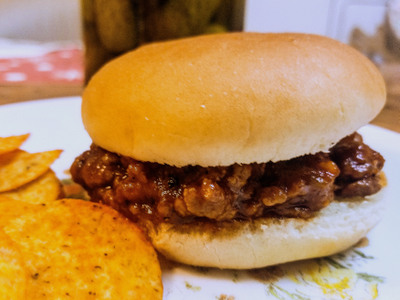
Tex-Mex Sloppy Joes and the Magic of Maid-Rite in Iowa
From time to time I get calls from around Iowa or across the country, usually from the media, about the history of Iowa food. Even the Travel Channel reached out for an upcoming Iowa episode of Bizarre Foods: Delicious Destinations. (Don’t miss this cool story!) People usually want to talk about one thing—Maid-Rites. I love sharing this story and have also cooked up my own twist on loose-meat sandwiches.
Just the other day a friend emailed me about Maid-Rites, wanting to know some other names for the sandwich. Here’s what I told her:
* Loose-meat sandwiches
* Taverns (a common term around Sioux City and parts of northwest Iowa)
* Beef burgers
* Canteens (in Ottumwa)
* Sloppy Joes (if they contain ketchup and other goodies in the mix)
* Yip-yips (at least in southern Illinois, or so I’ve been told!)
While you can sometimes find these sandwiches on some café menus in Iowa, as well as at the 30+ Maid-Rite chain restaurants around the Midwest, they are often turn up at potlucks, fundraiser meals, family get-togethers, civic group lunches and more.
Just when I think I’ve seen every type of these loose-meat sandwiches, there’s another version that pops up. When I shared my “How to Take Better Photos in 1 Minute” class with the Rockwell City Rotary Club recently, the meal included Tex-Mex inspired sloppy joes. While I don’t normally care for sloppy joes, I absolutely loved these sandwiches.
I loved them so much I was inspired to create my own version. These are flavorful, stick-to-your-ribs sandwiches that come together in a snap and can be as spicy or as mild as you like. They’re also an ultimate comfort food on these cold winter days here in Iowa.
Here’s the recipe. Enjoy! Also, keep reading below for the fascinating history of Maid-Rite in Iowa. This is an excerpt from my 2016 book, “Iowa’s Culinary History: Sweet Corn, Pork Tenderloins, Maid-Rites & More.” Order here to get your own signed copy of this fun book!
Tex-Mex Sloppy Joes
• 1 pound ground beef
• 1 small onion, chopped
• 2 garlic cloves, minced
• 1 cup ketchup
• 1 can (4 ounces) chopped green chilies
• 1/2 cup beef broth
• 1/4 cup chili sauce
• 1/2 to 1 teaspoon chili powder, to taste
• 1/2 teaspoon ground cumin
• 1/4 teaspoon crushed red pepper flakes, optional
• 1/4 teaspoon salt
• 1/4 teaspoon coarsely ground pepper
• 6 hamburger buns, split
• 2 tablespoons butter, softened
In a large skillet, cook beef and onion over medium heat for 6-8 minutes or until beef is no longer pink, breaking up beef into crumbles; drain. Add garlic; cook 1-2 minutes longer. Stir in the ketchup, chilies, broth, chili sauce and seasonings. Bring to a boil. Reduce heat; simmer, uncovered, for 15 minutes, stirring occasionally.
Meanwhile, spread cut sides of buns with butter. Place on baking sheets, buttered side up. Broil 4 in. from the heat for 1-2 minutes or until toasted. Serve beef mixture in buns.
Now for a tasty bite of Iowa history
Call it the king of the loose-meat sandwiches. A tried-and-true Iowa classic for nearly 100 years, the Maid-Rite is a sandwich unlike any other. But first, let’s clarify what a Maid-Rite is not.
It’s not a sloppy joe. It’s not a ground-beef concoction with ketchup, mustard and sugar in the mix. (Some of these “hybrid” sandwiches with traits of both a Maid-Rite and a sloppy joe can be found in Iowa, and some are quite tasty, but a true Maid-Rite they are not.) Finally, a Maid-Rite is not something you can leave out if you’re going to delve into the culinary history of Iowa.
The story of the Maid-Rite began in 1926, when Fred Angell, a meat cutter in Muscatine, developed a recipe with just the right combination of ground beef (with a specific grind size and meat/fat ratio) and a distinctive seasoning featuring Fred’s unique blend of spices. When a deliveryman tasted Fred’s new creation, he exclaimed, “This sandwich is made right!”
With that, the Maid-Rite legend was born. “The Maid-Rite recipe has stayed the same from the beginning,” said Bradley Burt, president and CEO of the Maid-Rite Corporation based in West Des Moines. “There’s no other sandwich like ours.”
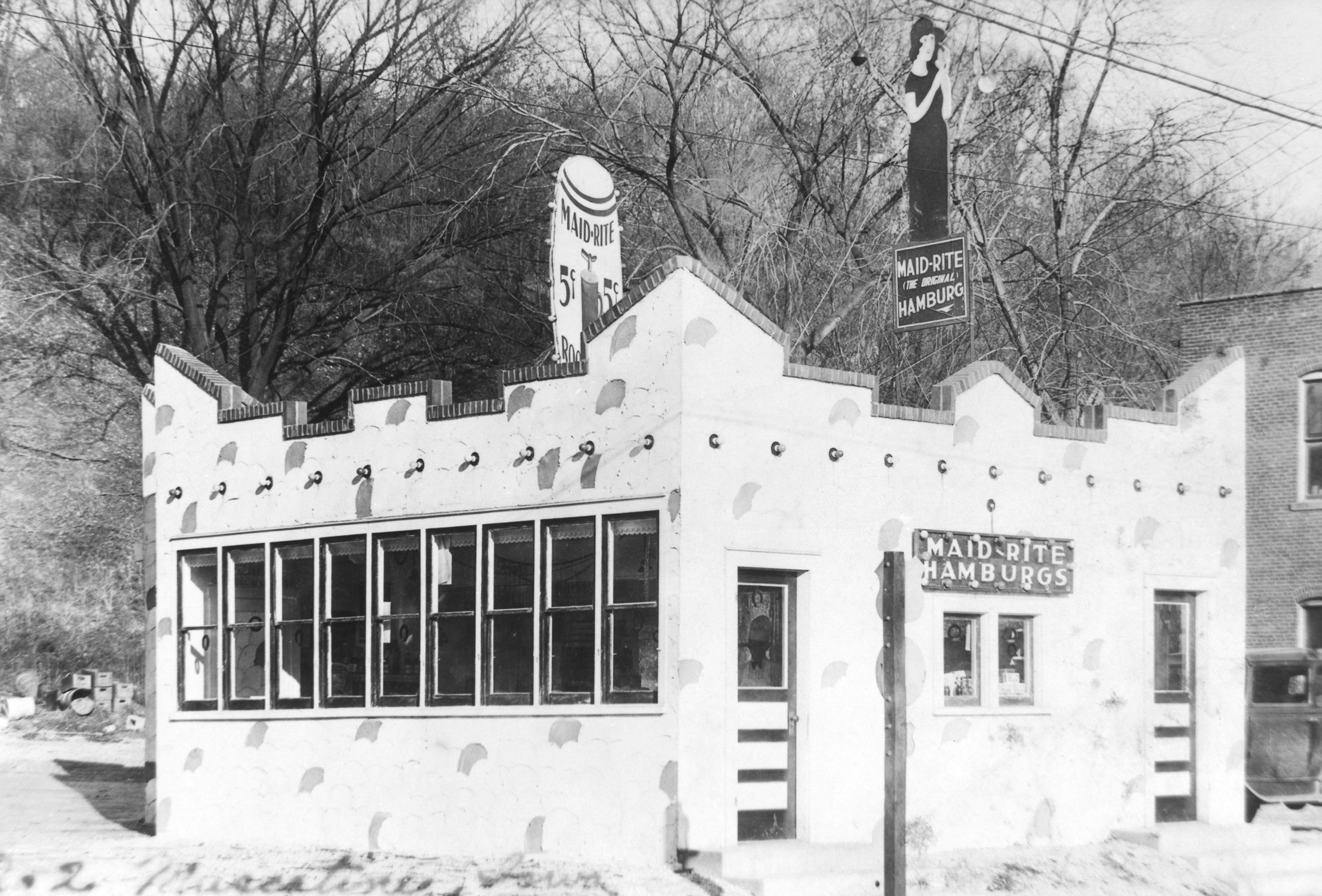
Early Maid-Rite sandwich shop. Photo courtesy of Maid-Rite Corp.
What started as a small Maid-Rite restaurant in Muscatine grew into one of America’s first quick-service, casual-dining franchise restaurants. Today there, are restaurants in eight Midwestern states, including 38 stores in Iowa. While the days of 5-cent Maid-Rites and homemade root beer are gone, Maid-Rite continues to pride itself on home-town hospitality. “Maid-Rite restaurants are still a gathering place in many small towns,” Burt said.
Some of these restaurants are as rich in history as the Maid-Rite sandwich itself. Taylor’s Maid-Rite in Marshalltown is a third-generation business that has been serving central Iowa for more than 80 years. Cliff Taylor purchased the 1928 franchise for $300. Cliff and his family operated Taylor’s Maid-Rite Hamburger Shop, baking pies at home, slicing whole pickles from Marshall Vinegar Works and buns from Strand’s Bakery.
After Cliff passed away in 1944, his son, Don, continued to run the restaurant. Don built a cooler in the basement of his home to store the hamburger that was ground daily. In 1958, he built a state-of-the-art Maid-Rite restaurant across the street from the original location, outfitting the new store with all stainless-steel equipment and two cash registers.
While various generations of the family have operated the business since then, many things haven’t changed. Like all Maid-Rite restaurants, each Maid-Rite at Taylor’s is made from 100% USDA Midwestern fresh ground beef served on a bun, with your choice of ketchup, mustard, onion and pickles. “We have stringent specifications for our beef,” Burt said.
Once you’ve tasted a real Maid-Rite, there’s no substitute. Many former Iowans don’t consider themselves to be officially back home in Iowa until they’ve eaten a Maid-Rite. “It’s quite a phenomenon,” Burt wait. Some Iowans can’t wait to get a taste of home. A group of snowbirds who spend their winters in Arizona host a Maid-Rite party in the Phoenix area each year for 150 guests, complete with Maid-Rite hats, t-shirts and aprons.
One of the biggest Maid-Rite fans of all would have to be Jim Zabel, who broadcast University of Iowa athletic events for 50 years. Before his passing in 2013, the legendary sportscaster and ultimate Iowa ambassador served as the Maid-Rite spokesman. He even made a commercial for Maid-Rite, complete with a riff on his high-energy slogan, “I love ‘em, I love ‘em, I love ‘em!”
Many Iowans stay loyal to their beloved Maid-Rites right to the end. Some people request them as their final meal, while others ask that Maid-Rites be served at their funeral dinner. “Maid-Rite is truly part of Iowa’s culture,” Burt said.
Want more?
Thanks for stopping by. I invite you to read more of my blog posts if you value intriguing Iowa stories and history, along with Iowa food, agriculture updates, recipes and tips to make you a better communicator.
If you like what you see and want to be notified when I post new stories, be sure to click on the “subscribe to blog updates/newsletter” button at the top of this page, or click here. Feel free to share this with friends and colleagues who might be interested, too.
Also, if you or someone you know could use my writing services (I’m not only Iowa’s storyteller, but a professionally-trained journalist with 20 years of experience), let’s talk. I work with businesses and organizations within Iowa and across the country to unleash the power of great storytelling to define their brand and connect with their audience through clear, compelling blog posts, articles, news releases, feature stories, newsletter articles, social media, video scripts, and photography. Learn more at www.darcymaulsby.com, or e-mail me at yettergirl@yahoo.com.
If you’re hungry for more stories of Iowa history, check out my top-selling “Culinary History of Iowa: Sweet Corn, Pork Tenderloins, Maid-Rites and More” book from The History Press. Also take a look at my latest book, “Dallas County,” and my Calhoun County” book from Arcadia Publishing. Both are filled with vintage photos and compelling stories that showcase he history of small-town and rural Iowa. Order your signed copies today! Iowa postcards are available in my online store, too.
Let’s stay in touch. I’m at darcy@darcymaulsby.com, and yettergirl@yahoo.com.
Talk to you soon!
Darcy
@Copyright 2019 Darcy Maulsby & Co. Blog posts may only be reprinted with permission from Darcy Maulsby.

Could Your Story Change Someone’s Life?
Are you a gambler? I’m not. I’ve never even bought a lottery ticket. Maybe it’s because I grew up on a farm. (I learned early on that farming is enough of a gamble—no casino needed!)
Perhaps that’s why I wasn’t listening too closely to a discussion on talk radio recently about online sports betting. It’s a sure bet that sports wagering will be debated this year in the Iowa Capitol.
I was listening to show off and on as I wrote a question-and-answer feature about how FFA influenced Iowa Secretary of Agriculture Mike Naig’s career. The gambling debate wasn’t on my mind—until a story suddenly broke through and froze my fingers on the keyboard.
The radio show’s guest, Tom Coates, told the story of a woman who had called his family’s business, Consumer Credit of Des Moines, when she was caught in the strangling grip of a gambling addiction. Her ordeal had become so overwhelming, so costly and so shameful that she felt she was out of options—other than ending it all.
When she was driving home one night, she decided this was it. She was going to crash her car and end her life. For someone so consumed with despair, it made sense to her.
It just so happened that she had her car radio on during that fateful trip, however. A commercial from Consumer Credit caught her attention. Through a combination of the right message delivered in the right channel at the right time to the right audience, this simple ad (and maybe a serious jolt of divine intervention), stopped this woman from following through with her deadly plan.
She drove to a nearby gas station (this was in the days before everyone had a cell phone) and called Consumer Credit, Iowa’s largest credit counseling service. Consumer Credit’s message of helping people in financial trouble solve their debt problems touched something deep inside her. By dialing the phone, she received the help she needed.
Thanks to a simple radio ad, this woman’s story had a much happier outcome than it could have.
Cutting through the clutter–4 key takeaways
While the stakes usually aren’t this high with most messages we share, that doesn’t mean our stories don’t matter. You will cut through the clutter of this noisy world when you 1.) add value by offering a solution for your audience, 2.) speak human, 3.) strike an emotional chord, and 4.) share your stories consistently through a variety of channels.
You just never know which story or which communication method will connect with the people you’re trying to reach. That’s why it pays to try a variety of formats, from online channels to print publications to audio or video.
Will you be top of mind when someone needs to hear your story? Never underestimate the power of a true story well told. Your story might just matter to someone more than you know.
Want more?
Thanks for stopping by. I invite you to read more of my blog posts if you value intriguing Iowa stories and history, along with Iowa food, agriculture updates, recipes and tips to make you a better communicator.
If you like what you see and want to be notified when I post new stories, be sure to click on the “subscribe to blog updates/newsletter” button at the top of this page, or click here. Feel free to share this with friends and colleagues who might be interested, too.
Also, if you or someone you know could use my writing services (I’m not only Iowa’s storyteller, but a professionally-trained journalist with 20 years of experience), let’s talk. I work with businesses and organizations within Iowa and across the country to unleash the power of great storytelling to define their brand and connect with their audience through clear, compelling blog posts, articles, news releases, feature stories, newsletter articles, social media, video scripts, and photography. Learn more at www.darcymaulsby.com, or e-mail me at yettergirl@yahoo.com.
If you’re hungry for more stories of Iowa history, check out my top-selling “Culinary History of Iowa: Sweet Corn, Pork Tenderloins, Maid-Rites and More” book from The History Press. Also take a look at my latest book, “Dallas County,” and my Calhoun County” book from Arcadia Publishing. Both are filled with vintage photos and compelling stories that showcase he history of small-town and rural Iowa. Order your signed copies today! Iowa postcards are available in my online store, too.
Let’s stay in touch. I’m at darcy@darcymaulsby.com, and yettergirl@yahoo.com.
Talk to you soon!
Darcy
@Copyright 2019 Darcy Maulsby & Co. Blog posts may only be reprinted with permission from Darcy Maulsby.

4 Key Lessons from Bud Light’s Super Bowl Corn-troversy
What a difference a day makes. Last Saturday, Feb. 2, I was in Altoona, Iowa, teaching my “Harvest Meals Made Easy” class at the Iowa Farm Bureau’s annual Young Farmer Conference. When I shared my three-ingredient recipe for the tastiest, simplest beer bread around, I noted that the type of beer you use isn’t a big deal, although the friend who shared the recipe with me preferred Bud Light.
Since I’m not much of a beer drinker, I didn’t give Bud Light another thought –until I was watching the Super Bowl last Sunday night.
I tuned in for two main reasons—1.) I’m a Tom Brady fan (see my blog post “Can a True Story Well Told Turn You into a Tom Brady Fan?), and 2.) as a marketer, I like to watch the commercials. I was less than impressed with most of the commercials (you paid more than $5 million for a 30-second spot and only came up with THAT???), although I loved the Microsoft ad “We All Win,” With a story revolving around a young boy from Texas, the ad showcased how Microsoft’s Xbox Adaptive Controller helps children with disabilities enjoy gaming. (This inspiring ad, which nearly brought tears to my eyes, topped the list of “most effective” ads with an UnrulyEQ score of 7.5, according to Ad Week.)
One ad that didn’t impress me was Bud Light’s slam against corn syrup. The ad emphasized that Bud Light doesn’t use corn syrup like competitors’ beers do. I thought it was an odd approach to advertise a mass-produced beer. It also ticked me off, since my family grows corn on our Century Farm, but I figured the stupid ad would just fade away into the wasteland of unremarkable, lame marketing.
I was wrong.
Bud Light versus…corn farmers?
Since I always like to hear what others think about these things, I tuned into the radio when I was headed to Ames the morning after the Super Bowl to attend a soil health conference. The general consensus on talk-radio was that the big game was boring (it was the lowest-scoring game in Super Bowl history), and most of the commercials were boring. No one on those shows was talking about the Bud Light commercial—yet.
But then the story exploded.
One of the first volleys in the battle came when my friend Kevin Ross, a farmer from Minden, Iowa, filmed a 9-second video and posted it to Twitter. As he dumped a can of Bud Light down the bathroom sink, he said, “Bud Light, you’re not standing with corn farmers. We’re not standing with you.”
That simple video helped unleash a media firestorm that led to coverage not only in Iowa media outlets, but Fox Business and other national media organizations. The day after the Super Bowl, the New York Times ran the article, “Bud Light Picks Fight with Corn Syrup in Super Bowl Ad.”
In the Feb. 4 story, Wendy Clark, chief executive of the advertising agency DDB Worldwide, noted that the back-and-forth spat may not have been the best result for Bud Light.
“I don’t know if anyone watching the Super Bowl necessarily cares about corn syrup, and it kicked up much ado about nothing,” Ms. Clark said. “It’s taken off into this corn syrup thing and not a Bud Light thing,” she added, “and I don’t know if that was the goal.”
What were they thinking?
I had to agree as I looked at this not as a farmer, but a storyteller who helps business leaders become thought leaders, attract skilled talent, appeal to more prospects and customers, and drive sales, one story at a time.
A cardinal rule of sharing true stories well told? Know your audience.
Back to Bud Light. Does anyone watching the Super Bowl care that much about corn syrup?
I thought about people I know who drink Bud Light. They tend to be hard-working, middle-class, patriotic Americans who just like to relax at the end of the day with an affordable, refreshing cold beer. They are not worried about corn syrup or health concerns related to excess corn syrup, especially when it comes to beer.
Is Bud Light really that clueless about its consumers?
Or are current Bud Light drinkers really the target audience for Bud Light’s advertisements?
Digging into the story behind the data
The question spurred me to investigate what research reveals about the typical Bud Light drinker.
According to InfoScout.com, which gathers consumer insights and demographics, Bud Light consumers are generally lower income, Hispanic and older. It appears that “older” is the key word that applies not just to Bud Light, but Budweiser, too. A Time.com article in 2014 noted that almost half of millennials had never drunk a Budweiser.
“The flagship Budweiser beer remains popular mostly among older folks, and its parent company, Anheuser-Busch InBev, is refocusing its marketing specifically on the millennial age bracket, the Wall Street Journal reports.”
Dazed and confused
Ahhhhh. I began to suspect what’s going on with the Bud Light corn syrup ad is a classic brand struggling to reinvent itself in a beer market that’s changing fast.
The stakes are high. Consider the 2018 Fortune.com article “Americans Are No Longer Drinking Budweiser and Bud Light Beers Like They Once Did,” which noted that sales of domestic lagers have receded as American consumers turn to craft beers, Mexican imports, wine and spirits to get their buzz.
In July 2018, Anheuser-Busch InBev (which manufactures Budweiser and Bud Light) reported that U.S. revenues fell 3.1 percent in the second quarter. The underperformance resulted in the company missing overall sales growth forecasts, triggering shares to drop more than 5 percent.
What’s going on?
Part of the challenge comes from millennials, who make up a sizeable percentage of legal beer consumers in America today. Millennials are the most skeptical generation in history when it comes to advertising. In an advertising-saturated world, this distrust in marketing hype means authenticity is a driving factor for millennials.
Hence the meteoric rise of craft beer, which is infused with authenticity. Compelling stories of local brewers who combine unique ingredients to brew beer in repurposed historical buildings that become hubs of the community capture the imagination—and beer drinkers’ dollars.
While overall U.S. beer volume sales were down 1 percent in 2017, according to the Brewers Association, craft brewer sales bucked the trend.
• Craft beers continued to grow at a rate of 5 percent by volume, reaching 12.7 percent of the U.S. beer market by volume.
• Retail dollar sales of craft increased 8 percent, up to $26 billion.
• Craft beers now account for more than 23% of the $111.4 billion U.S. beer market.
With all these challenges facing traditional brewers, what’s Bud Light to do? A corn syrup-focused ad during the big game clearly wasn’t the answer.
Backlash in the beer war
My friend Kevin, the corn farmer who serves as first vice president of the National Corn Growers Association, told Yahoo Finance the Bud Light ad “implied that [corn syrup] was an inferior product and that the other beers were doing something wrong because they use corn syrup in the brewing process,” and called it an “attack.”
Miller Lite took out a full-page ad in the New York Times on Feb. 6, stating in part, “The ‘corn syrup’ we source from America’s heartland helps make Miller Lite taste so great… It’s unfortunate that our competitor’s Big Game ad created an unnecessary #corntroversy.”
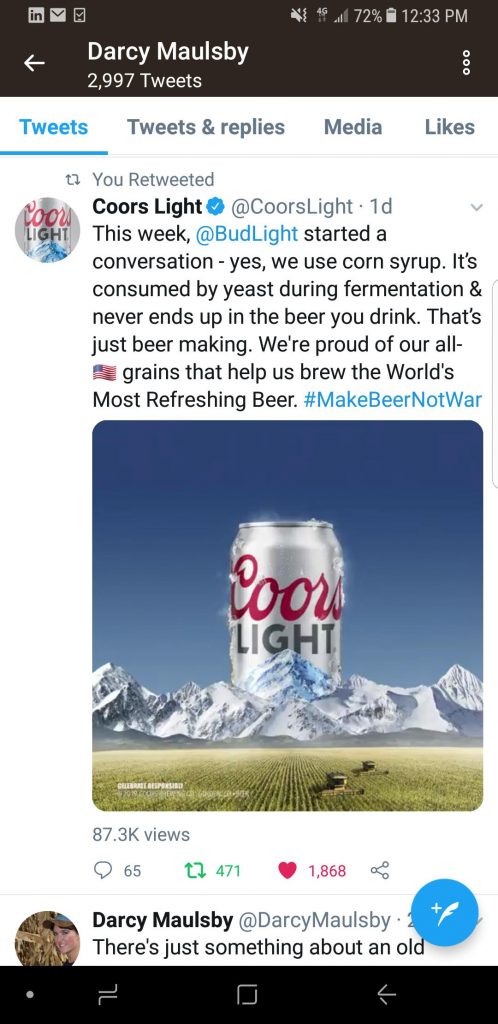 Also on Feb. 6, Coors Light tweeted, “This week, Bud Light started a conversation –yes, we use corn syrup. It’s consumed by yeast during fermentation & never ends up in the beer you drink. That’s just beer making. We’re proud of our all-American grains that help us brew the World’s Most Refreshing Beer. #MakeBeerNotWar”
Also on Feb. 6, Coors Light tweeted, “This week, Bud Light started a conversation –yes, we use corn syrup. It’s consumed by yeast during fermentation & never ends up in the beer you drink. That’s just beer making. We’re proud of our all-American grains that help us brew the World’s Most Refreshing Beer. #MakeBeerNotWar”
It didn’t take long before Bud Light began backtracking. In a tweet on Feb. 6, presented as a note from the king character from the ad, Bud Light said, “Yeesh! That escalated quickly… In the Bud Light Kingdom we love corn too! Corn on the cob, corn bread, popcorn—we just don’t brew with the syrup (what you also call ‘dextrose’).”
I’ll drink to that
So what can we take away from the Bud Light corn-troversy?
1. Know your audience.
2. Authenticity matters.
3. You don’t control your message, especially in a world of social media.
4. Instead of contrived marketing hype, tap into the power of true stories well told.
Want more?
Thanks for stopping by. I invite you to read more of my blog posts if you value intriguing Iowa stories and history, along with Iowa food, agriculture updates, recipes and tips to make you a better communicator.
If you like what you see and want to be notified when I post new stories, be sure to click on the “subscribe to blog updates/newsletter” button at the top of this page, or click here. Feel free to share this with friends and colleagues who might be interested, too.
Also, if you or someone you know could use my writing services (I’m not only Iowa’s storyteller, but a professionally-trained journalist with 20 years of experience), let’s talk. I work with businesses and organizations within Iowa and across the country to unleash the power of great storytelling to define their brand and connect with their audience through clear, compelling blog posts, articles, news releases, feature stories, newsletter articles, social media, video scripts, and photography. Learn more at www.darcymaulsby.com, or e-mail me at yettergirl@yahoo.com.
If you’re hungry for more stories of Iowa history, check out my top-selling “Culinary History of Iowa: Sweet Corn, Pork Tenderloins, Maid-Rites and More” book from The History Press. Also take a look at my latest book, “Dallas County,” and my Calhoun County” book from Arcadia Publishing. Both are filled with vintage photos and compelling stories that showcase he history of small-town and rural Iowa. Order your signed copies today! Iowa postcards are available in my online store, too.
Let’s stay in touch. I’m at darcy@darcymaulsby.com, and yettergirl@yahoo.com.
Talk to you soon!
Darcy
@Copyright 2019 Darcy Maulsby & Co. Blog posts may only be reprinted with permission from Darcy Maulsby.
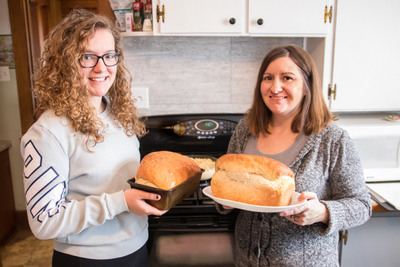
Baking is for Sharing: Best Bread, Grandma Ruby’s Cookies and Other Iowa Favorites
One of the most fun projects I write for clients is the Farm Cook feature that appears in Farm News. I get to meet interesting people in my area and fine-tune my culinary skills, thanks to the wonderful recipes and handy cooking tips they share. Here’s my latest Farm Cook feature with my new friend, Valerie. Enjoy!
What is it about baking that’s so intensely satisfying? Is it the rich aromas, the magic of creating something so comforting, or the opportunity to make family mealtime a priority? It’s all the above for Valerie Stuhrenberg of Pocahontas.
“I’ve always liked to cook and bake,” said Stuhrenberg, a Pocahontas native and registered nurse who works at Stewart Memorial Community Hospital in Lake City. “It runs in the family.”
Stuhrenberg, the youngest of 10 children, credits her father, Keith, with inspiring her love of cooking and baking. While his famous homemade cinnamon rolls were the hit of the neighborhood, Stuhrenberg especially loved his homemade pancakes.
“Dad learned to cook from his Grandma Stanton, who lived in Peterson,” said Stuhrenberg, who noted that he honed his culinary skills in various restaurants, including the Green Lantern Steak House in Decatur, Nebraska, and a restaurant he ran in Rockwell City.
Like many good cooks, Stuhrenberg’s father came from a line of home cooks who didn’t rely much, if at all, on recipes. This tradition of experimenting in the kitchen was passed on to Stuhrenberg, who’s not afraid of a challenge. When a friend who moved to Iowa asked if Stuhrenberg could make her a Kentucky Jam Cake, she wasn’t daunted.
“I said sure, even though I’d never heard of it before,” said Stuhrenberg, who had no trouble making this frosted spice cake.
Stuhrenberg has passed along her love of baking to her daughter, Ally, 14, a freshman at Pocahontas Area High School. When she was a member of the Guys and Gals of Grant 4-H Club, Ally Stuhrenberg’s baked goods, including Kentucky Jam Cake, won top honors at both the Pocahontas County Fair and the Iowa State Fair.
There’s always something homemade and good to eat at home, added Ally Stuhrenberg, who helps cook for her dad, Bob, and younger brother, Trevor, when her mother is working. Home cooking abounds at family get-togethers, added Valerie Stuhrenberg, who noted that all her siblings can cook, and one brother is a chef in the Omaha area. “It makes holidays really fun.”
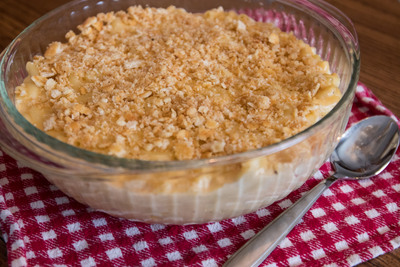
Homemade Baked Mac and Cheese
Baked Macaroni & Cheese
8 ounces elbow macaroni (2 cups dry macaroni)
4 tablespoons butter
4 tablespoons flour
1 / 2 teaspoon salt
Black pepper, to taste
1 / 4 teaspoon nutmeg
1 cup milk
1 cup cream or evaporated milk
2 cups cheddar cheese, shredded
Crumb topping:
Ritz crackers, crushed
Butter
Preheat oven to 400 degrees Fahrenheit. Cook macaroni, and set aside. Melt butter in a sauce pan. Whisk in the flour, salt, black pepper and nutmeg. Add milk and cream (or evaporated milk); boil for 2 minutes, stirring constantly. Turn down the heat, and simmer mixture for 10 minutes, stirring occasionally. Remove from heat.
Add cheese to cream sauce mixture. Combine with cooked elbow macaroni. Pour into baking dish and bake for 10 minutes. As the casserole bakes, combine crushed Ritz crackers and melted butter. (Stuhrenberg doesn’t measure exactly amounts.) After 10 minutes of baking, remove casserole from oven, sprinkle crumb topping mixture over the top, and bake the casserole for 10 more minutes. Remove from oven and serve.
(Note: all the ingredients, other than the crumb topping, can be combined and then frozen so the casserole can be baked later.)
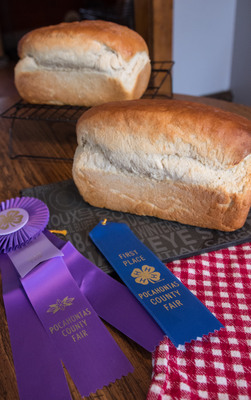
Award-winning Best Bread
Best Bread
4 1 / 2 teaspoons (2 packages) yeast
3 / 4 cup warm water
3 tablespoons soft butter
1 / 4 cup granulated sugar
1 tablespoon salt
2 2 / 3 cups additional water
9 to 10 cups flour
Put yeast and 3 / 4 cup warm water in mixer to proof for 5 minutes. Add butter, sugar, salt and the additional 2 2 / 3 cups water. Slowly add 5 cups of flour. Then add the remaining flour until a dough ball forms. Knead the dough for 5 to 10 minutes in mixer. (You may need to knead the dough in two batches.)
Put dough into a greased bowl, and let dough rise for 1 hour.
Punch down the dough, and separate the dough into two halves for two loaves of bread. Roll the dough out into two 12-inch by 12-inch squares. Then roll each square into the shape of a loaf of bread, tightly tucking in the seams and ends.
Place loaves in greased bread pans, and allow the dough to rise for 1 hour. Bake loaves for 15 minutes in an oven preheated to 425 degrees Fahrenheit. Cover loaves with aluminum foil, and bake 15 minutes more. Remove loaves from oven and cool on wire racks.
Grandma Ruby’s Cookies
This recipe came from Ruby Otto, a farm wife from the Plover area. “She would always make a big batch of these so she could take some to the field at planting and harvest and keep some in the freezer,” Valerie Stuhrenberg said.
2 cups granulated sugar
4 cups brown sugar
4 cups shortening
8 medium eggs
4 teaspoons vanilla
4 teaspoons baking soda
9 to 10 cups flour
2 teaspoons salt
24 ounces chocolate chips
24 ounces raisins
Preheat oven to 350 degrees Fahrenheit. Use an electric mixer to cream together the white sugar, brown sugar and shortening until smooth. Beat in the eggs one at a time, then stir in vanilla. In a separate bowl, combine the baking soda, salt and flour. Combine liquid mixture with dry mixture. Add chocolate chips and raisins to the batter.
Drop by large spoonfuls onto ungreased cookie sheets. Bake for about 10 to 13 minutes in the preheated oven, or until cookie edges are nicely browned. (More baking time creates a crisper cookie, while less baking time creates a chewier cookie.)
Kentucky Jam Cake with Caramel Frosting
Kentucky Jam Cake is a regional specialty. Instead of spreading the seedless blackberry jam between the cake layers, it is incorporated into the cake batter, along with a variety of spices, nuts and dried fruit. The moist, sweet, tangy cake is layered and covered with caramel frosting.
1 cup butter or margarine
2 cups granulated sugar
4 eggs
3 cups flour
1 teaspoon baking soda
1 teaspoon cinnamon
1 teaspoon nutmeg
1 teaspoon ground cloves
1 teaspoon ground allspice
1 cup buttermilk
1 teaspoon vanilla
1 cup of jam (seedless blackberry works well)
1 cup raisins
1 cup pecans, chopped
Cream butter and sugar. Beat in eggs, one at a time. In a separate bowl, sift all dry ingredients. Add the dry ingredients and buttermilk to the creamed mixture. (Alternate the addition of a portion of the dry mixture with a portion of buttermilk until all these ingredients have been incorporated into the batter.)
Add vanilla; mix well. Fold jam into cake batter. Add raisins and pecans; stir to combine.
Bake in two greased, floured baking pans for 35 to 45 minutes. Let cakes cool in pans for 15 minutes before turning the cakes onto waxed paper. Cool or freeze the cake before frosting with Caramel Frosting.
Caramel Frosting
2 1 / 4 cups brown sugar
1 1 / 2 sticks butter
2 tablespoons vanilla
3 tablespoons white corn syrup
4 1 / 2 tablespoons milk
2 1 / 4 cups confectioners’ sugar
Combine brown sugar, butter, vanilla, corn syrup and milk in a saucepan. Heat to melt the mixture. Remove mixture from heat; stir in confectioners’ sugar. Add sugar, as needed, until frosting has a glazed look and reaches the right spreading consistency. Spread frosting on the Kentucky Jam Cake quickly before the frosting hardens.
Black Magic Cake
1 3 / 4 cups all-purpose flour
2 cups granulated sugar
3 / 4 cup cocoa, unsweetened
2 teaspoons baking soda
1 teaspoon baking powder
1 teaspoon salt
2 large eggs
1 cup strong black coffee, cooled
1 cup buttermilk
1 / 2 cup vegetable oil
1 teaspoon vanilla extract
Combine flour, sugar, cocoa, baking soda, baking powder and salt in a large mixing bowl or stand mixer. Add eggs, coffee, buttermilk, vegetable oil and vanilla. Beat at medium speed for two minutes. Batter will be thin.
Pour batter into a greased and floured 9-inch by 13-inch pan, or two 9-inch round cake pans. Bake at 350 degrees for 35-40 minutes for a 9-inch by 13-inch pan, or 30-35 minutes for round pans. Remove cake from oven and cool. Spread with Easy Penuche Icing.
Easy Penuche Icing
1 / 2 cup butter
1 cup brown sugar, packed
1 / 4 cup milk
1 3 / 4 to 2 cups powdered sugar
Boil butter and brown sugar in saucepan for 2 minutes; remove from heat. Stir in milk. Mix in powdered sugar.
Want more?
Thanks for stopping by. I invite you to read more of my blog posts if you value intriguing Iowa stories and history, along with Iowa food, agriculture updates, recipes and tips to make you a better communicator.
If you like what you see and want to be notified when I post new stories, be sure to click on the “subscribe to blog updates/newsletter” button at the top of this page, or click here. Feel free to share this with friends and colleagues who might be interested, too.
Also, if you or someone you know could use my writing services (I’m not only Iowa’s storyteller, but a professionally-trained journalist with 20 years of experience), let’s talk. I work with businesses and organizations within Iowa and across the country to unleash the power of great storytelling to define their brand and connect with their audience through clear, compelling blog posts, articles, news releases, feature stories, newsletter articles, social media, video scripts, and photography. Learn more at www.darcymaulsby.com, or e-mail me at yettergirl@yahoo.com.
If you’re hungry for more stories of Iowa history, check out my top-selling “Culinary History of Iowa: Sweet Corn, Pork Tenderloins, Maid-Rites and More” book from The History Press. Also take a look at my latest book, “Dallas County,” and my Calhoun County” book from Arcadia Publishing. Both are filled with vintage photos and compelling stories that showcase he history of small-town and rural Iowa. Order your signed copies today! Iowa postcards are available in my online store, too.
Let’s stay in touch. I’m at darcy@darcymaulsby.com, and yettergirl@yahoo.com.
Talk to you soon!
Darcy
@Copyright 2019 Darcy Maulsby & Co. Blog posts may only be reprinted with permission from Darcy Maulsby.

Warm Up with Homemade Macaroni and Cheese Soup
It’s 10 degrees outside here in Iowa, the mercury is falling, it’s snowing, the wind is blowing, and I feel invincible—because I have a warm kettle of Mac and Cheese Soup on the stove.
“Soup puts the heart at ease, calms down the violence of hunger, eliminates the tension of the day, and awakens and refines the appetite,” noted Auguste Escoffier, the “chef of kings and king of chefs.”
I couldn’t agree more. Ask me my favorite thing to cook, and the answer is almost always soup. While I love proven recipes, I also like experimenting in the kitchen, like I did today. I made a batch of homemade macaroni and cheese a couple days ago that didn’t turn out quite as creamy as I wanted. I also had a small portion of leftover bacon mac and cheese from a recent meal at the Wild Rose Casino in Jefferson. What to do?
Hmmmm, could I combine these into mac and cheese soup? Is there such a thing as mac and cheese soup?
If not, let’s create it!
After a quick Google search for some culinary inspiration, I came up with a game plan. Since soup-making is more of an art than a science, I always tell people my recipes aren’t rules, just suggestions. You can reduce the milk if you like a thicker soup. Add more salt or pepper if you like. Enjoy a certain vegetable that’s not on the ingredient list? Try adding it. Do what makes sense to you.
A few cooking tips I do encourage:
• Use a pepper grinder to add fresh-ground pepper to your soup. I like to use a mix of red, black, green and white peppercorns for extra flavor.
• Do include the diced peppers. While I used a green pepper, you can user red, orange or yellow peppers, jalapenos, or whatever you have on hand. Peppers enhance the flavor, keep this soup from tilting to the blah side, and help you add extra veggies to your meal. Triple win!
• Go heavy on the onions when making soups. Alice Ann Dial, a neighbor and fantastic farm cook from my hometown of Lake City, Iowa, taught me to not skimp on onions. “They’re cheap and add so much flavor,” said Alice Ann, who learned this cooking trick during her days as a college student at Iowa State in Ames.
• You can make soup a day ahead of time and chill it in the refrigerator until you’re ready to serve. Many soups develop more flavor when they sit overnight, although my Mac and Cheese Soup is packed with flavor right from the start.
The main thing is to keep a spoon handy when you’re making soup, and taste as you go. Remember, you’re creating something special for you and the people you love. Tailor it just the way you like as you create a homemade batch of creamy, hearty, filling soup, perfect for a cold winter night or any time you just want a little extra comfort in your life.
Now please excuse me while I prepare supper and serve Mac and Cheese Soup for my family. Soup’s on!
Hearty Macaroni and Cheese Soup
Mac and Cheese Soup is creamy and oh-so-satisfying, just like mac and cheese. If you’re a mac and cheese fan, this soup is sure to become a favorite.
4 tablespoons butter
2 stalks celery, chopped
2 onions, chopped
2 cloves garlic, minced
2 carrots, grated or diced
1 green pepper, chopped
3 tablespoons all-purpose flour
4 cups chicken broth or vegetable broth
2 to 3 cups milk or half-and-half
1 teaspoon dry mustard
1 teaspoon Worcestershire sauce
1 / 2 teaspoon freshly ground pepper
1 / 4 teaspoon hot pepper sauce
Leftover macaroni and cheese
Bacon, cooked and chopped (optional)
OR
2 cups uncooked small pasta shells
8 ounces Velveeta cheese, cut into cubes
1 cup (4 ounce) shredded cheddar cheese
Melt butter in a Dutch oven or large pot. Add celery, onion, garlic, carrots and green pepper. Sauté until vegetables are soft.
Sprinkle flour on top of vegetable mixture. Whisk together and cook 1 minute.
Gradually whisk in chicken broth and milk. Bring to a simmer. Add dry mustard, Worcestershire sauce, pepper, and hot pepper sauce. Continue to simmer until soup thickens some. Add bacon, if desired.
This next step depends on whether you’re adding leftover macaroni and cheese, or you’re working with uncooked macaroni and the various cheeses. If you have leftover mac and cheese, it to the soup, let simmer for about 20 to 30 minutes, and serve.
If you don’t have leftover mac and cheese, cook pasta shells to al dente in salted water. The pasta will cook a little more in the soup and will absorb liquid, so be careful not to overcook.
Add cubes of Velveeta and stir until melted. Remove soup from heat and stir in cheddar cheese. Stir in cooked pasta, and serve. Enjoy!
Want more?
Thanks for stopping by. I invite you to read more of my blog posts if you value intriguing Iowa stories and history, along with Iowa food, agriculture updates, recipes and tips to make you a better communicator.
If you like what you see and want to be notified when I post new stories, be sure to click on the “subscribe to blog updates/newsletter” button at the top of this page, or click here. Feel free to share this with friends and colleagues who might be interested, too.
Also, if you or someone you know could use my writing services (I’m not only Iowa’s storyteller, but a professionally-trained journalist with 20 years of experience), let’s talk. I work with businesses and organizations within Iowa and across the country to unleash the power of great storytelling to define their brand and connect with their audience through clear, compelling blog posts, articles, news releases, feature stories, newsletter articles, social media, video scripts, and photography. Learn more at www.darcymaulsby.com, or e-mail me at yettergirl@yahoo.com.
If you’re hungry for more stories of Iowa history, check out my top-selling “Culinary History of Iowa: Sweet Corn, Pork Tenderloins, Maid-Rites and More” book from The History Press. Also take a look at my latest book, “Dallas County,” and my Calhoun County” book from Arcadia Publishing. Both are filled with vintage photos and compelling stories that showcase he history of small-town and rural Iowa. Order your signed copies today! Iowa postcards are available in my online store, too.
Let’s stay in touch. I’m at darcy@darcymaulsby.com, and yettergirl@yahoo.com.
Talk to you soon!
Darcy
@Copyright 2019 Darcy Maulsby & Co. Blog posts may only be reprinted with permission from Darcy Maulsby.

Homemade Mac and Cheese Soup


